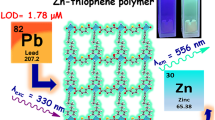Abstract
Coreactant plays a critical role for the application of electrochemiluminescence (ECL). Herein, N-(3-aminopropyl)diethanolamine (APDEA) has been explored as a potential coreactant for enhancing tris(2,2'-bipyridyl)ruthenium(II) ECL. It is much more effective than tripropylamine at gold and platinum electrodes although it has one primary amine group besides a tertiary amine group. The presence of primary amine group and hydroxyl groups in APDEA promotes the oxidation rates of amine and thus remarkably increases ECL intensity. The ECL intensities of the Ru(bpy)3 2+/APDEA system are approximately 10 and 36 times stronger than that of Ru(bpy)3 2+/tripropylamine system and about 1.6 and 1.14 times stronger than that of Ru(bpy)3 2+/N-butyldiethanolamine system at Au and Pt electrodes, respectively. The ECL intensity of the Ru(bpy)3 2+/APDEA system is 2.42 times stronger than that of Ru(bpy)3 2+/N-butyldiethanolamine at glassy carbon electrodes.








Similar content being viewed by others
References
Bard AJ, editor. Electrogenerated chemiluminescence. New York: Marcel Dekker; 2004.
Miao W. Electrogenerated chemiluminescence and its biorelated applications. Chem Rev. 2008;108(7):2506–53.
Richter MM. Electrochemiluminescence (ECL). Chem Rev. 2004;104(6):3003–36.
Hu L, Xu G. Applications and trends in electrochemiluminescence. Chem Soc Rev. 2010;39(8):3275–304.
Fungo F, Wong K-T, Ku S-Y, Hung Y-Y, Bard AJ. Electrogenerated chemiluminescence. 81. Influence of donor and acceptor substituents on the ECL of a spirobifluorene-bridged bipolar system. J Phys Chem B. 2005;109(9):3984–9.
Forster RJ, Bertoncello P, Keyes TE. Electrogenerated chemiluminescence. Annu Rev Anal Chem. 2009;2(1):359–85.
Liu Z, Qi W, Xu G. Recent advances in electrochemiluminescence. Chem Soc Rev. 2015;44(10):3117–42.
Huang R, Wei MY, Guo LH. Enhanced electrogenerated chemiluminescence of /tripropylamine system on indium tin oxide nanoparticle modified transparent electrode. J Electroanal Chem. 2011;656(1/2):136–9.
Doeven EH, Zammit EM, Barbante GJ, Hogan CF, Barnett NW, Francis PS. Selective excitation of concomitant electrochemiluminophores: tuning emission color by electrode potential. Angew Chem Int Ed. 2012;51(18):4354–7.
Fahnrich KA, Pravda M, Guilbault GG. Recent applications of electrogenerated chemiluminescence in chemical analysis. Talanta. 2001;54(4):531–59.
Zhou L, Huang J, Yang L, Li L, You T. Enhanced electrochemiluminescence based on Ru(bpy)32 + -doped silica nanoparticles and graphene composite for analysis of melamine in milk. Anal Chim Acta. 2014;824:57–63.
Xu Z, Guo Z, Dong S. Electrogenerated chemiluminescence biosensor with alcohol dehydrogenase and tris(2,2′-bipyridyl)ruthenium (II) immobilized in sol–gel hybrid material. Biosens Bioelectron. 2005;21(3):455–61.
Zhang L, Dong S. Electrogenerated chemiluminescence sensors using Ru(bpy)3 2+ doped in silica nanoparticles. Anal Chem. 2006;78(14):5119–23.
Yuan Y, Han S, Hu L, Parveen S, Xu G. Coreactants of tris(2,2′-bipyridyl)ruthenium(II) electrogenerated chemiluminescence. Electrochim Acta. 2012;82:484–92.
Choi JP, Bard AJ. Electrogenerated chemiluminescence (ECL) 79: reductive-oxidation ECL of tris(2,2′-bipyridine)ruthenium(II) using hydrogen peroxide as a coreactant in pH 7.5 phosphate buffer solution. Anal Chim Acta. 2005;541(1/2):141–8.
Hong L-R, Chai Y-Q, Zhao M, Liao N, Yuan R, Zhuo Y. Highly efficient electrogenerated chemiluminescence quenching of PEI enhanced Ru(bpy)3 2+ nanocomposite by hemin and Au@CeO2 nanoparticles. Biosens Bioelectron. 2015;63:392–8.
Yin XB, Sha BB, Zhang XH, He XW, Xie H. The factors affecting the electrochemiluminescence of tris(2,2’-bipyridyl)ruthenium(II)/tertiary amines. Electroanalysis. 2008;20:1085–91.
Miao W, Choi JP, Bard AJ. Electrogenerated chemiluminescence 69: the tris(2,2′-bipyridine)ruthenium(II), (Ru(bpy)32+)/Tri-n-propylamine (TPrA) system revisited. A new route involving TPrA• + cation radicals. J Am Chem Soc. 2002;124(48):14478–85.
Liu X, Shi L, Niu W, Li H, Xu G. Environmentally friendly and highly sensitive ruthenium(II) tris(2,2′-bipyridyl) electrochemiluminescent system using 2-(dibutylamino)ethanol as co-reactant. Angew Chem Int Ed. 2007;46(3):421–4.
Zu YB, Bard AJ. Electrogenerated chemiluminescence 66: the role of direct coreactant oxidation in the ruthenium tris(2,2')bipyridyl/tripropylamine system and the effect of halide ions on the emission intensity. Anal Chem. 2000;72:3223–32.
Jonathan KL, Michael JP. Electrogenerated chemiluminescence: an oxidative‐reduction type ECL reaction sequence using tripropyl amine. J Electrochem Soc. 1990;137:3127–31.
Huang B, Zhou X, Xue Z, Lu X. Electrochemiluminescence quenching of tris(2,2′-bipyridyl)ruthenium. TrAC-Trend Anal Chem. 2013;51:107–16.
Kebede N, Francis PS, Barbante GJ, Hogan CF. Electrogenerated chemiluminescence of tris(2,2′-bipyridine)ruthenium(ii) using common biological buffers as co-reactant, pH buffer, and supporting electrolyte. Analyst (Cambridge, U K). 2015;140(21):7142–5.
Noffsinger JB, Danielson ND. Generation of chemiluminescence upon reaction of aliphatic amines with tris(2,2'-bipyridine)ruthenium(III). Anal Chem. 1987;59(6):865–8.
Han S, Niu W, Li H, Hu L, Yuan Y, Xu G. Effect of hydroxyl and amino groups on electrochemiluminescence activity of tertiary amines at low tris(2,2′-bipyridyl)ruthenium(II) concentrations. Talanta. 2010;81(1/2):44–7.
Yin XB, Sha BV, He XW. Electrochemiluminescence from tris(2,2′-bipyridyl) ruthenium (II) in the presence of aminocarboxylic acid co-reactants. Sci China, Ser B: Chem. 2009;52:1394–401.
Jackson WA, Lacourse WR, Dobberpuhl D, Johnson DC. The voltammetric response of ethanolamine at gold electrodes in alkaline media. Electroanalysis. 1991;3(7):607–16.
Barnes KK, Mann CK. Electrochemical oxidation of primary aliphatic amines. J Org Chem. 1967;32(5):1474–9.
Adenier A, Chehimi MM, Gallardo I, Pinson J, Vila N. Electrochemical oxidation of aliphatic amines and their attachment to carbon and metal surfaces. Langmuir. 2004;20:8243–53.
Xue LL, Longhua Guo LH, Qiu B, Lin ZY, Chen GN. Mechanism for inhibition of Ru(bpy)3 2+/DBAE electrochemiluminescence system by dopamine. Electrochem Commun. 2009;11:1579–82.
Knight AW, Greenway GM. Relationship between structural attributes and observed electrogenerated chemiluminescence (ECL) activity of tertiary amines as potential analytes for the tris(2,2-bipyridine)ruthenium(II) ECL reaction. A review. Analyst (Cambridge, U K). 1996;121(11):101R–6R.
Acknowledgments
This project was kindly supported by the National Natural Science Foundation of China (no. 21475123), the Chinese Academy of Sciences (CAS)-the Academy of Sciences for the Developing World (TWAS) President’s Fellowship Programme, CAS-TWAS Postgraduate Fellowship, and CAS President’s International Fellowship Initiative (PIFI).
Author information
Authors and Affiliations
Corresponding author
Ethics declarations
Conflict of interest
The authors declare that they have no competing interests.
Additional information
Published in the topical collection Analytical Electrochemiluminescence with guest editors Hua Cui, Francesco Paolucci, Neso Sojic, and Guobao Xu.
Rights and permissions
About this article
Cite this article
Kitte, S.A., Wang, C., Li, S. et al. Electrogenerated chemiluminescence of tris(2,2'-bipyridine)ruthenium(II) using N-(3-aminopropyl)diethanolamine as coreactant. Anal Bioanal Chem 408, 7059–7065 (2016). https://doi.org/10.1007/s00216-016-9409-z
Received:
Revised:
Accepted:
Published:
Issue Date:
DOI: https://doi.org/10.1007/s00216-016-9409-z




